Alami Alor, Pulau Alor, IndonesiaContents of this Issue: Alami Alor, Pulau Alor, Indonesia Buoyancy Cell Failure Causes Diver Fatality A Caribbean Influx of Deadly Weed Undercurrent Receives $1000 Environmental Grant Okeanos Aggressor II, Caño Island, Costa Rica Oceanic/Hollis Regulator Recall Tulsa Diver Bent in Cozumel Gets Insurance Shock Plastic Packaging and the Diving Industry Discover Scuba Diving Course Leads to Fatality Reminiscing about Being Adrift at Sea Blubber For SEALs and Penguin Feathers Editorial Office: Ben Davison Publisher and Editor Undercurrent 3020 Bridgeway, Suite 102 Sausalito, CA 94965 luxury resort, luxurious reefs, reasonable prices from the July, 2018 issue of Undercurrent
Dear Fellow Diver, From the moment I donned my gear on the sturdy wooden jetty in front of the resort and took a giant stride into the warm water, I felt I'd made the right decision in coming to Alami Alor. It was my afternoon checkout dive, and a school of jacks pursued a swarm of silversides right under the dock. After my affable British guide, Pete, helped my buddy get her weights right, he pointed out nudibranchs, crabs, and shrimps aplenty on a reef jam-packed with critters, soft corals, dancing shrimp and even two mandarin gobies.
Getting to the far reaches of Indonesia is complicated, so I always book a day or two's layover after my transatlantic flight. Good thing. My flight from Bali to Alor was canceled, so the resort, which had booked my local air, rerouted me, eating up the extra day, but I missed no diving. At the airport, my two friends and I were whisked away on the resort van for the one-hour, back-roads trip to the remote Alami Alor, where we were warmly greeted by Valentina, the managerin- training, from Chile. She showed me my exquisite, spacious beachfront cabin with floor-to-ceiling windows, a king and single bed (I got the cabin to myself without a single supplement, because I booked seven months in advance), airconditioning, open-air bathroom and shower (3-5 minutes of hot water and slippery tiles), surrounded by plants and trees, and two lounge chairs out front (April weather was too hot -- high 80ºs (27ºC) -- and humid to sit outside). The smiling crew kept my cabin and the resort spotless.
Co-owner, Lauren, an American, had the cooks make me some delicious nasigoreng (noodles with veggies and an egg on top) to tide me over until 7 p.m. dinner. Beforehand, we were briefed: they cater only to experienced divers, don't teach courses and only operate mid-March to early December. Her British husband, Max, runs the dive operation and she the resort; both are dive instructors, and often joined us. They built the boutique resort -- it only holds 12 guests -- five years ago.
They have no dive shop, per se, but have a nice air-conditioned camera room with plenty of plugs, lights, room to work, and a big rinse tank, as well as two small rooms next to the camera room for computers, GoPros, and smaller cameras. They offer good-quality rental gear and asked me in advance if I would need anything. When my spotting light flooded on my housing, they lent me one. The two-tank morning dive went out at 8 a.m., the afternoon dive at 3 p.m., night dive at 5:30 p.m., and you can dive the house reef all you want. While the water was between 80ºF (27ºC)and 84ºF (29ºC), a few times it dropped to 78ºF (26ºC). My five mil with a furry vest/hood was fine for every dive, which generally lasted 60-70 minutes. They chose sites according to the phase of the moon, tides, and currents, which they knew well from four years of observing here. Morning dives were breathtaking. The pristine, diverse, and intricate corals seemed untouched. Anthias, durgons, snappers, jacks, tangs and butterflyfish abounded. Huge barrel sponges covered most sites. The visibility was 100 feet+(30M+) on our first wall dives. Alor is not a protected marine park area; there is no dynamite fishing, but there are some fish traps. When I came up from one dive, there were a dozen village kids swimming and paddling in their dugout canoes, asking to have photos taken, and shouting "I love you Mr.!"
All the afternoon dives were in the muck, with 20- to 40-foot (6-12m) visibility in the black sand bay, and every bit as good as Lembeh Strait (sadly, with some trash, as at Lembeh). On my firsts dive, I spotted frogfish, hairy rhinopias, stonefish, seahorses, and nudibranchs (some no larger than a grain of rice), pygmy cuttlefish, and a banded sea snake, as well as several varieties of shrimp, an ornate bristleworm, and snake eels. Our sharp-eyed guide, Nikko, found a small coconut octopus half-buried in some plant debris, put his finger two inches (51mm) from its head, and a tentacle quickly attached its tiny suckers to his finger, then tugged a couple of times before giving up and pulling back. About the only critters I didn't see were a blue-ring octopus, a mimic octopus and a wonderpus, all of which are common in the Lembeh Strait. Bad luck?
I do think, however, there were too many afternoon and night muck dives. In fact, half the dives are muck. Why not alternate a few with the beautiful coral reefs? Lauren told me distances, currents, gas, and staff consideration led to them selecting afternoon muck dives within 5-10 minutes of the resort. I wasn't the only one who wished to see more of the reefs and walls, and we paid pretty good money to do that.
We dived a large, long, deep wall named "Current Alley," hoping to see scalloped hammerhead sharks. Within five minutes of reaching 80 feet (24m), a lone hammerhead came in from the blue, passing right in front of me. Ten minutes later, 20 appeared in front of us and passed by, uninterested. Ten minutes later, a pair swished within 30 feet (9m) of me, and then a large eagle ray flapped past, then another. But a second trip there produced none. That's diving, folks. However . . . Motoring back to the resort, we hit some swirling currents, and the lookout shouted,"Mola-Mola!" Lauren motored us to within five meters of an ocean sunfish and, two of us with mask, fins, and snorkels slipped into the water, kicking like crazy to catch up to the 6 foot-high (1.8m) Mola-Mola gently flapping its dorsal and caudal fins. I got a full-on side view, and my buddy got some good video until we ran out of gas. I had two other Mola snorkeling encounters. Their boats (about 24 feet/7.3m)) were nearly new -- one came to a dead stop for a short time, but a quick fuel line repair got it going -- spic-and-span and perfect for six divers and two guides. Together, we back-rolled off the gunnels, re-entered up a sturdy steel ladder after the crew lifted our BCDs/tanks up. They handled my big rig camera carefully. They provided shared plastic crates to keep miscellaneous dive accessories -- computers, defoggers, masks, etc. -- but I found it chaotic sorting through everyone's stuff to find my own. A simple mesh bag for each diver would be simpler. I never had to handle my dive equipment -- they put it on the boat, rinsed and dried it overnight. The dive crew, Pete and two Indonesian guides, was extremely helpful, and assisted us getting in and out of the boat, and offering sunburn lotion when I got too much sun. When my dive buddy got a bad cramp doffing her BCD and fins -- three times, in fact -- they helped her stretch her leg in the water and massaged her calf until she stopped writhing in pain. Yet all was not perfect in paradise, as one dive guide argued about something with the dive manager, abruptly quit and left. I don't think they missed him. A dive at Black Rhino produced three rhinopias -- a red one, orange one, and hairy beige one -- the first time they've ever spotted three in one dive. I videoed the hairy one walking for more than a minute -- what a comical sight!
And about that slippery bathroom tile? One diver slipped, whacked her head, and pulled her quadriceps, was unable to dive for a day and hobbled for the next seven days. Others had near-misses. The owners carefully helped her walk to/from her cabin and onto/off of the boat all week and even had a local carve her a walking stick. But, those tile floors call out for rubber mats. One morning dive we did two nice large caves, one with a 10-foot (3m) entry and air pocket at the top, the other with a three-foot (1m) entry,so we went single file. Tuna schooled around the exit. The surge was challenging but manageable. The second dive was Apuri Bay, which was a giant carpet of various anemones -- thousands really -- in all directions. We entered at 83ºF (28ºC)and exited at 78ºF (26ºC) because of a chilly upwelling that came through, but the viz was crystal-clear: 100 feet/30m plus. I captured dozens of anemone nest shots (with some spectacular macro close-ups of the varied anemone fingers) and half a dozen clownfish types. On my no-dive day, we toured a traditional mountain village, where nine betelnut-chewing families lived in 3-level thatched roof, open-air houses. They prepared us sweetened coffee, and our guide walked us around explaining their subsistence farming of corn, cassava, bananas, and coconuts. The town's open-air market was colorful and fragrant, but not always to a western nose! In the afternoon, a dive guide took us on a scenic boat ride along the shores of the bay, past villages with Christian and Muslim houses of worship, kids playing in the water and fishermen jigging for dinner. Dolphins played in the bow wake and jumped for sardines (another day, a juvenile manta twice leaped fully from the water alongside our boat). So, Alami Alor is a great, remote, luxurious boutique outpost, offering some of Indonesia's finest diving. It's a destination that's hard to beat, so much so, in fact, that it's sold out for the remainder of 2018. For Indonesia, it is priced well on the high side, but, indeed, worth every penny. -- D.S. Our undercover diver's bio:"I got the diving bug watching Sea Hunt as a kid, got certified in 1983, but didn't start diving the world until 1991. I've logged more than 1,200 dives in the Caribbean, Indonesia, Australia, Tahiti, Palau, PNG, Maldives and the Philippines . While I love the convenience of liveaboards, I also enjoy resorts for their relaxing pace and beauty . My life goal is to dive on my 90th birthday. (Only 24 years to go!)"
|

I want to get all the stories! Tell me how I can become an Undercurrent Online Member and get online access to all the articles of Undercurrent as well as thousands of first hand reports on dive operations world-wide
| Home | Online Members Area | My Account |
Login
|
Join
|
| Travel Index |
Dive Resort & Liveaboard Reviews
|
Featured Reports
|
Recent
Issues
|
Back Issues
|
|
Dive Gear
Index
|
Health/Safety Index
|
Environment & Misc.
Index
|
Seasonal Planner
|
Blogs
|
Free Articles
|
Book Picks
|
News
|
|
Special Offers
|
RSS
|
FAQ
|
About Us
|
Contact Us
|
Links
|
3020 Bridgeway, Ste 102, Sausalito, Ca 94965
All rights reserved.

 The next morning we dived for an hour along an eye-popping wall of soft corals with swarms of chromis, butterfly fish, durgons, anthias, wrasses, fairy basslets, and silversides. Brilliant tube worms, nudibranchs and a plethora of sea squirts decorated the coral during one of my most "fishy" dives ever, a wide-angle shooter's dream. As the current increased, we moved to the shallows for 20 minutes, gazing at the colorful soft and hard corals and reef fish.
The next morning we dived for an hour along an eye-popping wall of soft corals with swarms of chromis, butterfly fish, durgons, anthias, wrasses, fairy basslets, and silversides. Brilliant tube worms, nudibranchs and a plethora of sea squirts decorated the coral during one of my most "fishy" dives ever, a wide-angle shooter's dream. As the current increased, we moved to the shallows for 20 minutes, gazing at the colorful soft and hard corals and reef fish.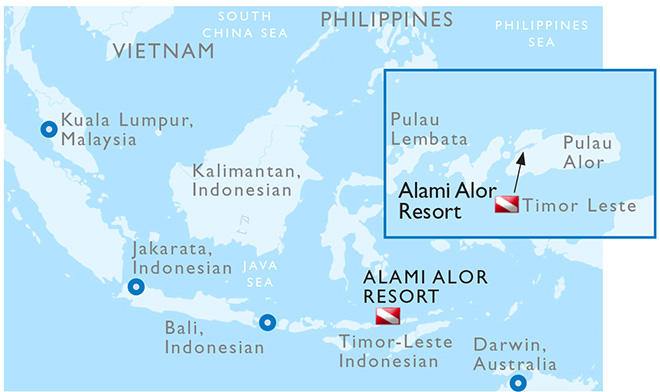
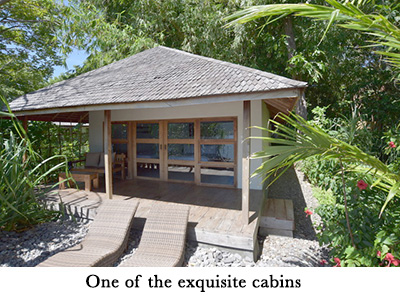 The cathedral-ceilinged aquatic-themed main building combined the dining
room and lounge, with fans keeping the breeze going. With shoes off, we all sat
at a long table for meals, served family style. The lounge had a big screen TV,
which we used nightly to share photos, followed by lots of oohs and aahs. With my
down time, I'd relax, read, or snorkel the house reef, where there was plenty of
action, including blacktip reef sharks.
The cathedral-ceilinged aquatic-themed main building combined the dining
room and lounge, with fans keeping the breeze going. With shoes off, we all sat
at a long table for meals, served family style. The lounge had a big screen TV,
which we used nightly to share photos, followed by lots of oohs and aahs. With my
down time, I'd relax, read, or snorkel the house reef, where there was plenty of
action, including blacktip reef sharks. Great Wall was one of the more beautiful wall dives I've ever made. From 40-70 feet (12-21m), the wall was jam-packed with hundreds of soft and hard corals, sea squirts, anemones, clownfish, barrel sponges with hairy crabs in their crevices, fans, ghost pipefish, anemone crabs, translucent shrimps and massive clusters of bubble corals. Swarms of anthias, butterflyfish, jacks, snappers, and wrasses filled the water. One could shoot either macro or wide angle and be a happy photographer. The top of the reef during our safety stop was like being in a Disney movie (think Finding Nemo), it was so rich and perfect.
Great Wall was one of the more beautiful wall dives I've ever made. From 40-70 feet (12-21m), the wall was jam-packed with hundreds of soft and hard corals, sea squirts, anemones, clownfish, barrel sponges with hairy crabs in their crevices, fans, ghost pipefish, anemone crabs, translucent shrimps and massive clusters of bubble corals. Swarms of anthias, butterflyfish, jacks, snappers, and wrasses filled the water. One could shoot either macro or wide angle and be a happy photographer. The top of the reef during our safety stop was like being in a Disney movie (think Finding Nemo), it was so rich and perfect.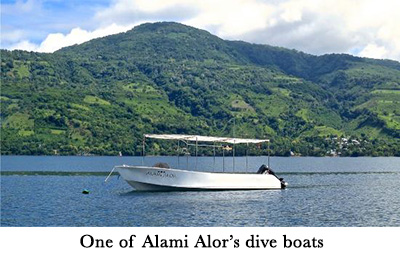 Our first 70-minute
night dive was at Mucky
Mosque, in front of a village
mosque five minutes from the
resort. It was full of critters,
nonstop ghost pipefish,
frogfish, nudis, harlequin
shrimp, squid, cuttlefish, leaf scorpionfish, snowflake eel and a Spanish dancer. I got some great shots with
the help/spotting by my dive guide. We surfaced after 70 minutes to a sky filled
with stars, with few lights to pollute the view. On other night dives, I found a
beautiful little bobtail squid, cuttlefish transforming their shapes, textures, and
colors before my eyes, an orangutan crab, hairy frogfish (first one they've seen
in three years), even a half a dozen octopuses: Coconut and long-armed. Because
the night muck dives had so many critters, I stopped the afternoon dives and just
did night dives.
Our first 70-minute
night dive was at Mucky
Mosque, in front of a village
mosque five minutes from the
resort. It was full of critters,
nonstop ghost pipefish,
frogfish, nudis, harlequin
shrimp, squid, cuttlefish, leaf scorpionfish, snowflake eel and a Spanish dancer. I got some great shots with
the help/spotting by my dive guide. We surfaced after 70 minutes to a sky filled
with stars, with few lights to pollute the view. On other night dives, I found a
beautiful little bobtail squid, cuttlefish transforming their shapes, textures, and
colors before my eyes, an orangutan crab, hairy frogfish (first one they've seen
in three years), even a half a dozen octopuses: Coconut and long-armed. Because
the night muck dives had so many critters, I stopped the afternoon dives and just
did night dives.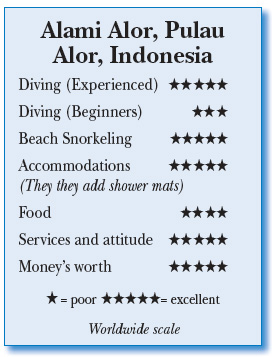 Guests from Germany, Switzerland, China, UK, and
U.S. came and went, and we all got along well, telling
our endless dive stories. An arriving English
couple immediately took to their room with a severe
stomach/intestinal upset that took them out of diving
for three full days.
Guests from Germany, Switzerland, China, UK, and
U.S. came and went, and we all got along well, telling
our endless dive stories. An arriving English
couple immediately took to their room with a severe
stomach/intestinal upset that took them out of diving
for three full days.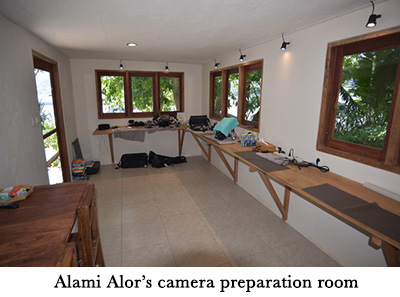 For such a remote outpost, the food was top of the line, and the owners and expat staff joined us regularly for the served meals. There was one menu per lunch and dinner, a mix of Indonesian (rice, a saucy chicken, curries, nasi goreng, local spinach, fruit) and some western food (e.g., French fries, steak, green beans). One night we had giant prawns with coconut curried pumpkin and Indonesian spinach, another night fresh tuna with a mild pepper salsa, cassava greens, and another night chicken and vegetarian skewers with rice and green beans cooked with tempeh. Chinese eggplant, salad, and rice were one delicious lunch. And endless cakes for dessert: crumb, coconut, chocolate, and spice. They accommodated two of us who were "low-carb" eaters with extra protein (e.g., chicken) and sautéed veggies. They served good French-press coffee and I brought ground decaf from home, which they brewed for me after dinners. In the morning, at 7 a.m., I could wake up over a cup of fresh coffee before a breakfast of eggs, omelets, granola, fruit, toast, and fresh pastries. Oh: an alert. Tiny mosquitos were pesky, and I had to spray up for breakfast and especially dinner (the resort provides spray).
For such a remote outpost, the food was top of the line, and the owners and expat staff joined us regularly for the served meals. There was one menu per lunch and dinner, a mix of Indonesian (rice, a saucy chicken, curries, nasi goreng, local spinach, fruit) and some western food (e.g., French fries, steak, green beans). One night we had giant prawns with coconut curried pumpkin and Indonesian spinach, another night fresh tuna with a mild pepper salsa, cassava greens, and another night chicken and vegetarian skewers with rice and green beans cooked with tempeh. Chinese eggplant, salad, and rice were one delicious lunch. And endless cakes for dessert: crumb, coconut, chocolate, and spice. They accommodated two of us who were "low-carb" eaters with extra protein (e.g., chicken) and sautéed veggies. They served good French-press coffee and I brought ground decaf from home, which they brewed for me after dinners. In the morning, at 7 a.m., I could wake up over a cup of fresh coffee before a breakfast of eggs, omelets, granola, fruit, toast, and fresh pastries. Oh: an alert. Tiny mosquitos were pesky, and I had to spray up for breakfast and especially dinner (the resort provides spray). Diver's Compass: My 12-night stay (3 dives/day included) as a single cost me US$3,300, including nitrox ... Internet in the dining room is barely good enough for emails ... Optional half-day tours run $70 for 2-4 people ... They provide free laundry service ... They offer massages, but I was disappointed that the masseuse was away all 12 days of my stay ... They sell wine and beer by the glass and no other alcohol ... The nearest chamber is in Bali.
Diver's Compass: My 12-night stay (3 dives/day included) as a single cost me US$3,300, including nitrox ... Internet in the dining room is barely good enough for emails ... Optional half-day tours run $70 for 2-4 people ... They provide free laundry service ... They offer massages, but I was disappointed that the masseuse was away all 12 days of my stay ... They sell wine and beer by the glass and no other alcohol ... The nearest chamber is in Bali.